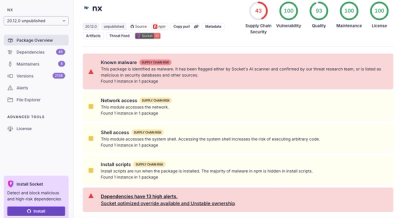
Security News
/Research
Wallet-Draining npm Package Impersonates Nodemailer to Hijack Crypto Transactions
Malicious npm package impersonates Nodemailer and drains wallets by hijacking crypto transactions across multiple blockchains.
Plotting of seismic data using variable-density or variable-area wiggle displays.
The seisplot module provides a single, highly flexible method plot() to display seismic data. A second method toggle() can be used to create animations that can be saved as images or movies.
The module was designed to get decent displays of seismic data in a way that is more convenient than going through many individual Matplotlib function calls explicitly. However, if required Matplotlib methods can also be called directly. The code is pure Python and kept deliberately simple to get students participating our Geophysics classes and exercises going with Python and seismic data.
     
Required: numpy, matplotlib
Install from PyPI:
$> pip install seisplot
Install directly from gitlab:
$> pip install git+https://gitlab.kit.edu/thomas.hertweck/seisplot.git
Editable install from source:
This version is intended for experts who would like to test the latest version or make modifications. Normal users should prefer to install a stable version.
$> git clone https://gitlab.kit.edu/thomas.hertweck/seisplot.git
Once you acquired the source, you can install an editable version of seisplot with:
$> cd seisplot
$> pip install -e .
For a demonstration of various features and much more, please visit the "examples" folder where several Jupyter notebooks (tutorials) are available.
Plotting seismic data (for instance, read with our seisio package and therefore available as Numpy structured array including trace headers) can be as simple as:
import seisplot
fig, ax = seisplot.plot(data, haxis="offset", width=4, height=6,
vlabel="Time (s)", hlabel="Offset (m)",
vmajorticks=0.2, vminorticks=0.1,
hminorticks=500, vgrid="major")
The variables fig and ax are standard Matplotlib figure and axis handles
that can be used to tweak the display further. You could also create those
first using fig, ax = plt.subplots(1, 1) and pass them to the plot() method.
In this way, it is possible to, for instance, create several seismic displays
in one figure, or create displays that share the y-axis (usually "time").
A display toggle can, for instance, be produced in the following way:
ani, fig, ax = seisplot.toggle([data_1, data_2, data_diff],
interval=1000, repeat_delay=0,
hlabel="offset (m)", vlabel="time (s)")
The returned animation-artist object can be used to save an animated image or a movie.
An animated wipe can, for instance, be produced in the following way:
ani, fig, ax = seisplot.wipe(data_1, data_2, blit=True,
nwipe=30, wipecolor="blue",
interval=5, repeat_delay=0,
hlabel="offset (m)", vlabel="time (s)")
Again, the returned animation-artist object can be used to save an animated image or a movie.
Dr. Thomas Hertweck, geophysics@email.de
This project is licensed under the LGPL v3.0 License - see the LICENSE.md file for details
FAQs
Plotting of seismic data
We found that seisplot demonstrated a healthy version release cadence and project activity because the last version was released less than a year ago. It has 1 open source maintainer collaborating on the project.
Did you know?

Socket for GitHub automatically highlights issues in each pull request and monitors the health of all your open source dependencies. Discover the contents of your packages and block harmful activity before you install or update your dependencies.

Security News
/Research
Malicious npm package impersonates Nodemailer and drains wallets by hijacking crypto transactions across multiple blockchains.

Security News
This episode explores the hard problem of reachability analysis, from static analysis limits to handling dynamic languages and massive dependency trees.

Security News
/Research
Malicious Nx npm versions stole secrets and wallet info using AI CLI tools; Socket’s AI scanner detected the supply chain attack and flagged the malware.